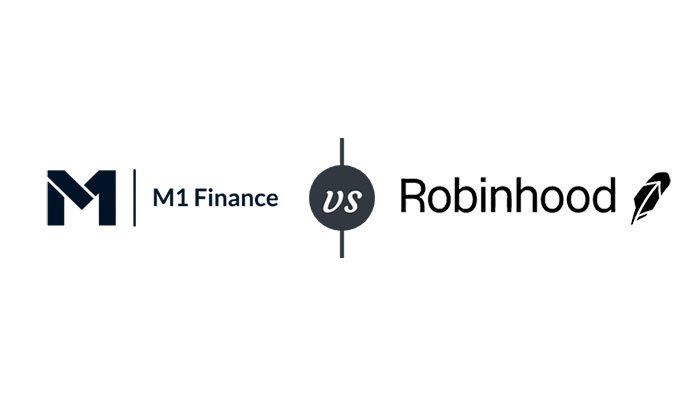Both M1 Finance and Robinhood walk a fine line between simplicity and bare-bones minimalism. As investors, we generally welcome applications that are easy to use, so long as they pack all the essential features we have come to expect, like an array of account types, investment options, and friendly customer support.
And these two platforms essentially do just that. Modest Money’s Bob Haegele calls them “good options for new investors,” apps that are “beautiful and easy to use” in his M1/Robinhood comparison article. And though commission-free trading apps are all the rage amongst today’s youthful investors, anyone looking to get into stock investing will do well to check out M1 Finance or Robinhood. At the forefront of the “app-ification” of investing, these two offerings are only receiving more and more recognition.
M1 Finance and Robinhood: easy to use, cost efficient, and effective. But what’s the difference between them? Is it the name alone, or perhaps a few superficial features? Or, is there something more critical at stake in this comparison?
Reviews of M1 Finance point to an all-encompassing investing that allows one to automate their trading experience partly or even entirely. M1’s “expert pies” give you access to a range of individual stocks and electronically traded funds (ETFs) and make managing your portfolio easier than ever, with one-click rebalancing and very low management fees.
Robinhood is one of the more popular investing applications, and with good reason. It’s an incredibly simple application to use, sports a beautiful interface, and even allows users to invest in cryptocurrencies. Though shrouded in controversy during the pandemic, Robinhood has since bounced back, and is more popular with young investors than ever before.
Two simple, easy to use applications. Both offer low rates and commission-free trading, though M1 Finance places a greater emphasis on passive investing. So, what really are the differences? Which of these applications is best for you?
Let’s delve a little deeper into M1 Finances vs. Robinhood.
M1 Finance – Pies and More Pies
When it comes to M1 Finance, “pies” are the name of the game. As the platform’s most defining and powerful feature, M1 Finance’s pie charts give novice investors the opportunity to see their holdings objectively. M1’s pies consist of different asset classes, and they can even be made of different investments within the same asset class.
Founded in 2015, the company’s CEO Brian Barnes was on the warpath to create something different in the world of finance products. Barnes was even quoted as saying that “the financial services industry has lacked any meaningful innovation for far too long, and I decided it was time for a change.” This “change” came via pie-based investing, a system which makes investing both easy and fun.
M1 Finance Key Features
- Pies: M1 Finance’s pies work just like pie charts, with individual “slices” representing different parts of your portfolio, all of which add up to a weighted total of 100. Manipulating these slices is easy, and it is simple to keep a visual account of just where your money is invested and which parts of your portfolio are prospering.
- Expert Pies: users can make up their own pies, or pick from a variety of predetermined, “expert pies” which include general investing, responsible investing, income earners, and hedge fund followers, just to name a few.
- Account Types: M1 Finance gives users access to a range of account types, from traditional IRA and SEP IRA to brokerage, trust, and checking accounts.
- Management Fees: M1 Finance is mostly devoid of fees, thankfully. Unless you sign up for M1 Plus, you need only worry about expense ratios on ETFs. Another perk is the fact that there are no minimum account balances.
Robinhood – For the Masses
Robinhood is known as a pioneer in the field of commission-free stock trading. Founded by Vladimir Tenev and Baiju Bhatt in 2013, Robinhood has been on the vanguard of the financial markets’ democratization for some years. Their company ethos is equally egalitarian, for they want to “provide everyone with access to financial markets, not just the wealthy.”
Robinhood is a bigger name than M1 Finance, but how do they stack up?
Robinhood Key Features
- Investment Options: with Robinhood, users can invest in stocks, options, ETFs, and cryptocurrencies.
- Management Fees: as is the case with M1 Finance, Robinhood has very little in the way of fees. They charge $75 for outgoing wires, and Robinhood Gold, their premium membership edition, runs a mere $5 per month.
- Fractional Shares: Robinhood has recently introduced fractional shares, allowing users with little capital to buy into strong blue-chip companies.
M1 Finance vs. Robinhood – Who Comes Out on Top?
These kinds of things are never easy to call, and when it comes to these two industry stalwarts, the line separating them is even thinner.
Both applications are tailored towards the novice user, with intuitive features and pleasing interfaces. What’s more, both have very low fees and rates. It all comes down to what you wish to accomplish.
For example, those looking to “day trade” are better off with Robinhood, as M1 Finance only features one daily trading window. On the other hand, if you are looking to cash in on mutual funds and bonds, M1 Finance is your obvious choice, as these asset types are not supported by Robinhood.
In a nutshell, M1 Finance is better suited for passive investors who are looking to set up their future and retirement. If you are a young gunslinger looking for day trading thrills, Robinhood is a no-brainer.
Get started today with M1 Finance or Robinhood and rev up your finances.
Related M1 Finance Comparison Posts
- M1 Finance vs. Webull
- M1 Finance vs. Vanguard
- M1 Finance vs. Fidelity
- M1 Finance vs. Robinhood
- M1 Finance vs. Betterment
- M1 Finance vs Charles Schwab
- M1 Finance vs SoFi Invest
- M1 Finance vs. Acorns
- M1 Finance vs. Wealthfront
Related Robinhood Comparison Posts



































